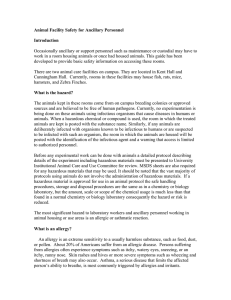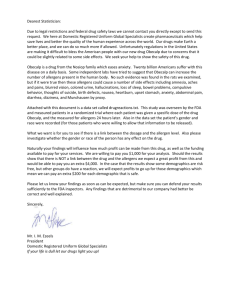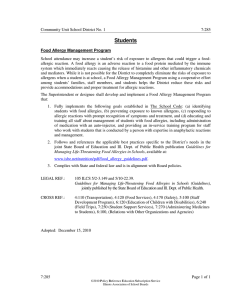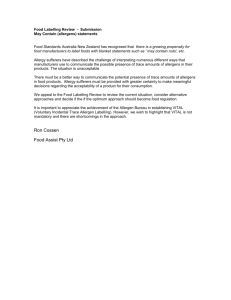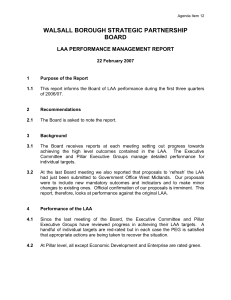Laboratory Animal Allergies
advertisement
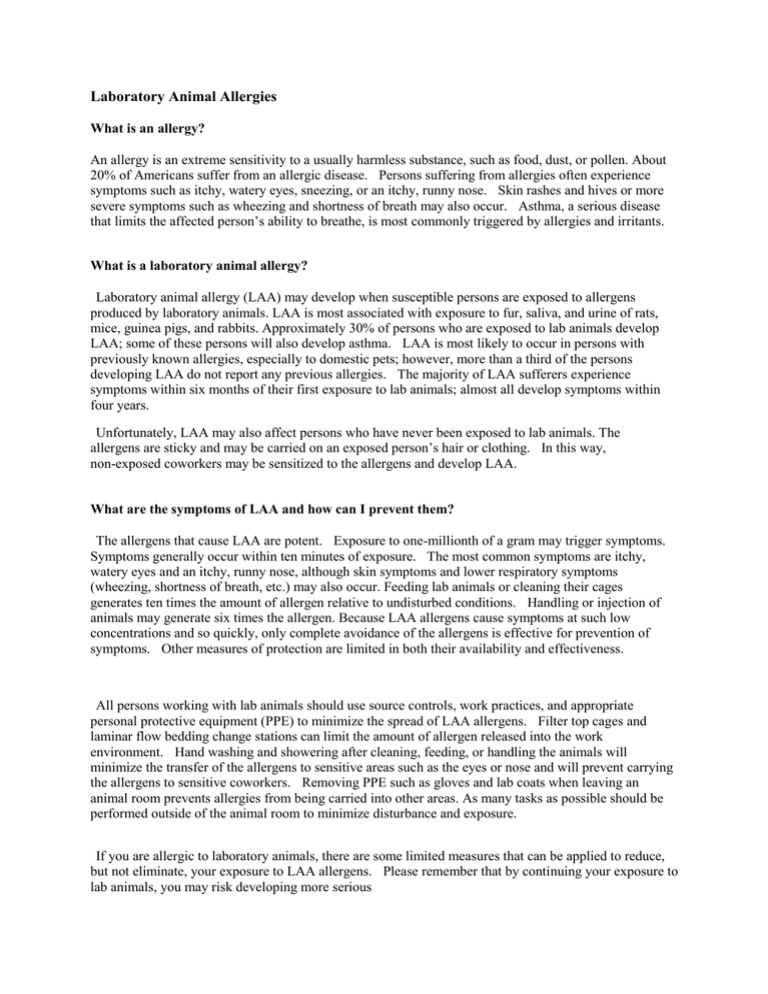
Laboratory Animal Allergies What is an allergy? An allergy is an extreme sensitivity to a usually harmless substance, such as food, dust, or pollen. About 20% of Americans suffer from an allergic disease. Persons suffering from allergies often experience symptoms such as itchy, watery eyes, sneezing, or an itchy, runny nose. Skin rashes and hives or more severe symptoms such as wheezing and shortness of breath may also occur. Asthma, a serious disease that limits the affected person’s ability to breathe, is most commonly triggered by allergies and irritants. What is a laboratory animal allergy? Laboratory animal allergy (LAA) may develop when susceptible persons are exposed to allergens produced by laboratory animals. LAA is most associated with exposure to fur, saliva, and urine of rats, mice, guinea pigs, and rabbits. Approximately 30% of persons who are exposed to lab animals develop LAA; some of these persons will also develop asthma. LAA is most likely to occur in persons with previously known allergies, especially to domestic pets; however, more than a third of the persons developing LAA do not report any previous allergies. The majority of LAA sufferers experience symptoms within six months of their first exposure to lab animals; almost all develop symptoms within four years. Unfortunately, LAA may also affect persons who have never been exposed to lab animals. The allergens are sticky and may be carried on an exposed person’s hair or clothing. In this way, non-exposed coworkers may be sensitized to the allergens and develop LAA. What are the symptoms of LAA and how can I prevent them? The allergens that cause LAA are potent. Exposure to one-millionth of a gram may trigger symptoms. Symptoms generally occur within ten minutes of exposure. The most common symptoms are itchy, watery eyes and an itchy, runny nose, although skin symptoms and lower respiratory symptoms (wheezing, shortness of breath, etc.) may also occur. Feeding lab animals or cleaning their cages generates ten times the amount of allergen relative to undisturbed conditions. Handling or injection of animals may generate six times the allergen. Because LAA allergens cause symptoms at such low concentrations and so quickly, only complete avoidance of the allergens is effective for prevention of symptoms. Other measures of protection are limited in both their availability and effectiveness. All persons working with lab animals should use source controls, work practices, and appropriate personal protective equipment (PPE) to minimize the spread of LAA allergens. Filter top cages and laminar flow bedding change stations can limit the amount of allergen released into the work environment. Hand washing and showering after cleaning, feeding, or handling the animals will minimize the transfer of the allergens to sensitive areas such as the eyes or nose and will prevent carrying the allergens to sensitive coworkers. Removing PPE such as gloves and lab coats when leaving an animal room prevents allergies from being carried into other areas. As many tasks as possible should be performed outside of the animal room to minimize disturbance and exposure. If you are allergic to laboratory animals, there are some limited measures that can be applied to reduce, but not eliminate, your exposure to LAA allergens. Please remember that by continuing your exposure to lab animals, you may risk developing more serious symptoms. Rarely, potentially life-threatening conditions can occur from an extreme exposure like an animal bite. Personal protective equipment (gloves, lab coat, coveralls, etc.) that completely covers your street clothing should be worn. This PPE should be laundered or replaced before you wear it again. Hand washing and showering after exposure to allergens should assist dramatically in removing allergens. In consultation with the Office of Research Safety and a Health Center Physician, a respirator may be selected and worn to filter out allergens from breathing air. Respirators can only provide the protection they are designed for if they are properly selected for the task, if they are fitted to the wearer, and if they are maintained so they continue to provide the protection required for the work situation. Improperly worn or maintained respirators can actually increase exposures as well as placing a greater strain on the respiratory system. . For more information call ORS at 2-4996 or e-mail to tom@rags.kent.edu What should I do if I think that I have LAA? If, after reviewing this sheet and discussing it with your supervisor, you believe you are experiencing LAA, you should seek medical evaluation.
